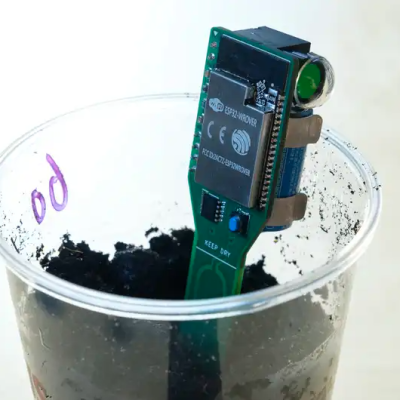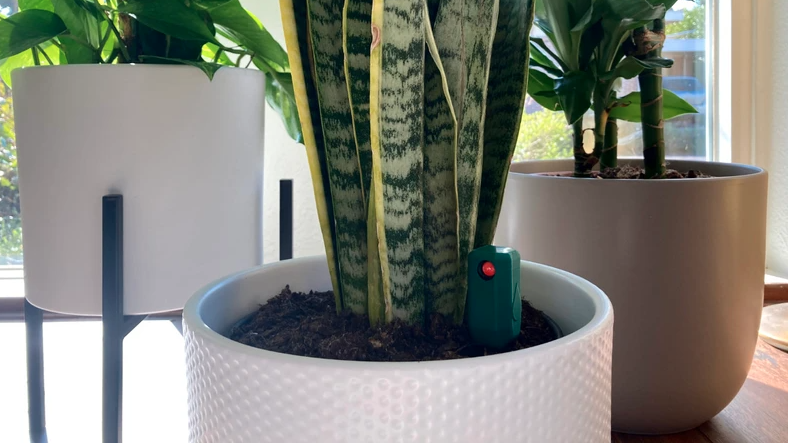Soil sensors are handy things, but while sensing moisture is what they do, how they handle that data is what makes them useful. Ensuring usefulness is what led [Maakbaas] to design and create an ESP32-based soil moisture sensor with wireless connectivity, deep sleep, data logging, and the ability to indicate that the host plant needs watering both visually, and with a push notification to a mobile phone.

The visual notification part is pretty nifty, because [Maakbaas] uses a small flip-dot indicator made by Alfa-Zeta. This electromechanical indicator works by using two small coils to flip a colored disk between red or green. It uses no power when idle, which is a useful feature for a device that spends most of its time in a power-saving deep sleep. When all is well the indicator is green, but when the plant needs water, the indicator flips to red.
The sensor itself wakes itself up once per hour to take a sensor measurement, which it then stores in a local buffer for uploading to a database every 24 measurements. This reduces the number of times the device needs to power up and connect via WiFi, but if the sensor ever determines that the plant requires water, that gets handled immediately.
The sensor looks great, and a 3D-printed enclosure helps keep it clean while giving the device a bit of personality. Interested in rolling your own sensor? The project also has a page on Hackaday.io and we’ve previously covered in-depth details about how these devices work. Whether you are designing your own solution or using existing hardware, just remember to stay away from cheap probes that aren’t worth their weight in potting soil.
















Bistable displays!
One problem I see, compared with a sensor that occasionally blinks an LED, is that there is no discernible difference between the appearance of the device when it is working properly, and when it has completely failed. If the battery goes dead while the soil is moist, for example, the indicator will show green continuously and indefinitely.
Not that this would apply directly, but I’m reminded of an indicator that a very old GE electric clock had: below the “12” on the dial, it had a small window, behind which was a colored dot. The dot was blue in normal operation, and it was painted on a pivoting flag that was painted half blue and half red. This flag was held in the blue position by the magnetic field of the motor that ran the clock, but if power was lost for more than a few seconds, it would fall, revealing the red portion through the window. This would show the user of the clock that the time display should not be relied upon, since the clock had lost power. The flag could be reset, by the way, by tilting the clock 90 degrees to where it was again held by the motor’s magnetic field.
Like I said, not directly applicable, but it would be nice to have some way of knowing whether the sensor is still functioning. Maybe something simple, like a button that, when pressed, would cause the indicator to switch states twice, i.e., red-green-red or green-red-green.
I guess, since this device posts a log of its activities, it would be sufficient for a computer that doesn’t have to worry about power consumption to check for activity. This could work for any number of sensors.
I’m amazed the Good Enough company ever sold a device with such a clever and useful feature, let alone spent the money engineering it. How times have changed.
This was long ago. The clock I remember from around 1965, but was old at the time. Coincidentally, a friend of mine has this very model; his is still running today. Times have indeed changed.
Surely there are already mechanical moisture indicators, this seems to me like the old joke about using your phone line with a modem to connect your computer to the internet, and then use the the computer to make a voice call.
Which made good sense at certain times in the past.
Dial up internet access was (at various times and places) essentially paid for by your monthly internet fee. The individual dial up sessions didn’t affect your phone bill.
You could make a long distance call through an internet service for next to nothing compared to the usual long distance rates of the day.
Still does hence VoIP.
min. amplitude: 250mA
min. voltage: 4,5V
on single cell? think again, use small eink as one bit display.
Modern RGB LEDs are very efficient and be operated at uA of current and be visible. That is an easy to find and cheap way to make a simple indicator that would consume less current on average than the ESP.
https://www.electrobob.com/the-coolness-of-rgb-leds/
No power indicator – like the weather rock?
https://en.wikipedia.org/wiki/Weather_rock
Imagine just having a simple mechanism that was sensitive to humidity and toggled between two states with a couple of screws to fine tune the range and threshold point.
Okay, I can imagine that. Now tell me how this works for soil moisture. That’s a different thing, you know.